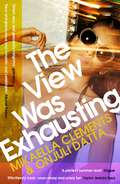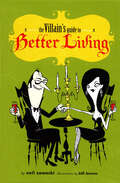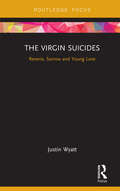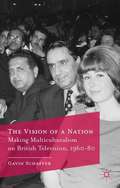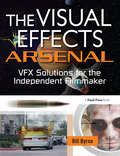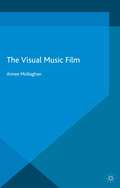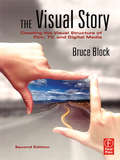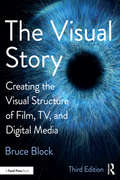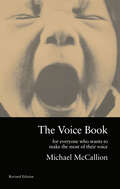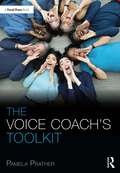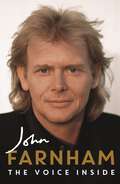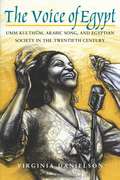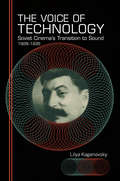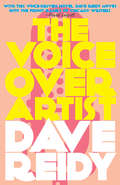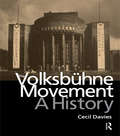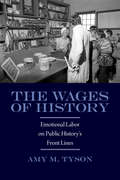- Table View
- List View
The View Was Exhausting: their love story has fooled the cameras but what is real behind the scenes?
by Mikaella Clements Onjuli Datta'Effortlessly cool, razor-sharp and crazy fun - I couldn't put it down' TAYLOR JENKINS REID, bestselling author of Daisy Jones & the Six'I loved the chemistry' FRANCES CHA, author of If I Had Your Face'The complex, Hollywood love story we've all been waiting for' EMILY HENRY, bestselling author of Beach Read'A glamorous power ride through fame, misogyny and racism, with a swoony romance' JULIE COHEN--- Whitman 'Win' Tagore and Leo Milanowski are the greatest love story of our time. International movie star meets the beautiful son of a millionaire. Their kisses write headlines and their fights break the internet. Nobody needs to know it's not real.Win knows that Hollywood demands perfection - especially from a woman of colour.Leo just wants to enjoy life, and shift press attention away from his dysfunctional family.Together they control the narrative.Except this time, on the shores of Saint-Tropez, Leo is hiding a secret that is about to send Win's world spinning. Now everyone's dream couple must confront the messy reality of their relationship. Just as they're starting to realise that they might actually be falling in love...THE VIEW WAS EXHAUSTING is a bold, swoon-worthy and utterly modern debut novel about truth, fame and privilege - and how we love now.---'The smart, sexy and genuinely insightful rom com I've been waiting for' GAL-DEM'A must-read book of the summer' CULTUREFLY'A book to read in the sun with a glass of wine and nothing else to do all day. Fun, sexy and totally gripping' LAURA KAY, author of The Split'Deft, funny and tender, The View Was Exhausting is as smart as it is swoon-worthy' JULIA ARMFIELD author of Salt Slow'A sexy, scorching treat - fresh and ultra modern, I devoured it' HAZEL BARKWORTH, author of Heatstroke'Funny, warm and gorgeously written...I was totally swept away' JANE HEALEY, author of The Animals at Lockwood Manor'A sexy, scorching treat - fresh and ultra modern, I devoured it' VICTORIA GOSLING, author of Before the Ruins
The View from Babylon: The Notes of a Hollywood Voyeur
by Donald RawleyRawley paints the definitive portrait of Hollywood in the '90s. A lifelong L.A. inhabitant, Rawley takes you on a tour beyond the city's edge - from Malibu's shining white beaches to lonely desert communities to big-studio arenas where life speeds by in "Hollywood time." He introduces a memorable cast of characters - a wistful, recovering methamphetamine addict; a loving father and dedicated ex-soldier driven by heartbreaking failure; the always glamorous, never satisfied Hollywood denizens at one of the industry's "big-big-big" premieres. The View from Babylon is a portrait of the city that reflects our deepest dreams and darkest desires.
The View from Highway 1: Essays on Television
by Michael J. ArlenA series of excellent essays that critique television and society. A highly recommended follow-up read to Arlen's "Living Room War".
The Viewpoints Book
by Tina Landau Anne BogartThe Viewpoints is a technique of improvisation that grew out of the postmodern dance world. It was first articulated by choreographer Mary Overlie, who broke down the two dominant issues performers deal with--space and time--into six categories. Since that time, directors Anne Bogart and Tina Landau have expanded her notions and adapted them for actors to function together spontaneously and intuitively and to generate bold, theatrical work.The Viewpoints are a set of names given to certain principles of movement through time and space--they constitute a language for talking about what happens on stage. Coupling this with Composition, which is the practice of selecting and arranging the separate components of theatrical language into a cohesive work of art, provides theatre artists with an important new tool for creating and understanding their art form.Primarily intended for the many theatre artists who, in the last several years, have become intrigued with Viewpoints yet have had no single source to refer to in their investigations. It can also be used by anyone with a general interest in collaboration and the creative process, whether in art, business or daily life.Anne Bogart is Artistic Director of the SITI Company, which she founded with Japanese director Tadashi Suzuki in 1992. She is the recipient of two OBIE Awards and a Bessie Award, and is an associate professor at Columbia University. Her recent works include Alice's Adventures; Bobrauschenbergamerica; Small Lives, Big Dreams; Marathon Dancing; and The Baltimore Waltz.Tina Landau, noted director and playwright, whose original work includes Space (Time magazine 10 Best), Dream True (with composer Ricky Ian Gordon) and Floyd Collins (with composer Adam Guettel), which received the Lucille Lortel Award for Best Musical, an OBIE Award and seven Drama Desk nominations. She has been an ensemble member of the Steppenwolf Theatre Company since 1997.
The Villain's Guide to Better Living
by Neil ZawackiA fiendish lifestyle guide for today’s discerning evil-doers from the author of the perilously popular How to Be a Villain.All those aspiring ne’er-do-wells who cackled all the way to the cash register with the Neil Zawacki’s How to Be a Villain are ready to embrace the finer points of the evil life with The Villain’s Guide to Better Living. It covers all the topics contemporary villains care about, such as: Home d cor—Gothic? Apocalyptic? Ikea? Friends—Do I have any? Can I make them? Work—Should I be a mad scientist or obsessed with revenge? Or both?
The Virgin Suicides: Reverie, Sorrow and Young Love (Cinema and Youth Cultures)
by Justin WyattBased on the best-selling novel by Jeffrey Eugenides, The Virgin Suicides is director Sofia Coppola’s evocative debut feature of young love, sex, loss and family pressures in mid-1970s America. Acclaimed by both critics and audiences on release, the film is now viewed as a remarkable and bold feature by a significant female director addressing many issues related to youth, female sexuality and family. This book helps readers understand the film’s significance and the stylistic and storytelling choices made by director Coppola. The analysis of the film occurs around three interlocking arguments: the unusual structuring absence in the film, the intricate manner through which music is used in the drama, communication and character creation, and the film’s careful and specific referencing of advertising in the 1970s (the decade of the film’s narrative). The film’s enigmatic structure and unique storytelling devices and their relationship to female adolescence, sexuality and ideology are also considered in depth. Without solving the mysteries of the film, the book is designed to uncover the reasons why the film continues to fascinate viewers so many years after its release.
The Virtual Life of Film
by D. N. RodowickAs almost (or, truly, virtually) every aspect of making and viewing movies is replaced by digital technologies, even the notion of "watching a film" is fast becoming an anachronism. With the likely disappearance of celluloid film stock as a medium, and the emergence of new media competing for an audience, what will happen to cinema--and to cinema studies? In the first of two books exploring this question, D. N. Rodowick considers the fate of film and its role in the aesthetics and culture of moviemaking and viewing in the twenty-first century. Here Rodowick proposes and examines three different critical responses to the disappearance of film in relation to other time-based media, and to the study of contemporary visual culture. Film, he suggests, occupies a special place in the genealogy of the arts of the virtual: while film disappears, cinema persists--at least in the narrative forms imagined by Hollywood since 1915. Rodowick also observes that most so-called "new media" are fashioned upon a cinematic metaphor. His book helps us see how digital technologies are serving, like television and video before them, to perpetuate the cinematic as the mature audiovisual culture of the twentieth century--and, at the same time, how they are preparing the emergence of a new audiovisual culture whose broad outlines we are only just beginning to distinguish.
The Vision of a Nation
by Gavin SchafferTelling the stories behind television's approaches to race relations, multiculturalism and immigration in the 'Golden Age' of British television, the book focuses on the 1960s and 1970s and argues that the makers of television worked tirelessly to shape multiculturalism and undermine racist extremism.
The Visual Effects Arsenal: VFX Solutions for the Independent Filmmaker
by Bill ByrneBuild your VFX arsenal with quick-access, step-by-step instruction on how to create today's hottest digital VFX shots. This essential toolkit provides techniques for creating effects seen in movies such as 300, Spiderman 3, Predator and others, with lessons on how-to:* splatter blood or digitally lop someone's arm off* create a scene with actors running from an explosion* create the "twin effect" (same actor, same location, 2 performances)* produce space-ship dog fightsOrganized in a 'cookbook' style, this allows you to reference a certain effect in the index and immediately access concise instructions to create that effect. Techniques are demonstrated in each of the most popular software tools- After Effects, Final Cut Studio, Photoshop, and Combustion are all covered. Brilliant, 4-color presentation provides inspiration and stimulating visual guidance to the lessons presented, while the downloadable resources contain project media files enabling you to put concepts learned into immediate practice.
The Visual Life of Romantic Theater, 1780-1830
by Diane Piccitto Terry F. RobinsonThe Visual Life of Romantic Theater examines the dynamism and vibrancy of stage spectacle and its impact in an era of momentous social upheaval and aesthetic change. Situating theatrical production as key to understanding visuality ca. 1780-1830, this book places the stage front and center in Romantic scholarship by re-envisioning traditional approaches to artistic and social creation in the period. How, it asks, did dramaturgy and stagecraft influence aesthetic and sociopolitical concerns? How does a focus on visuality expand our understanding of the historical experience of theatergoing? In what ways did stage performance converge with visual culture beyond the theater? How did extratheatrical genres engage with theatrical sight and spectacle? Finally, how does a focus on dramatic vision change the way we conceive of Romanticism itself? The volume’s essays by emerging and established scholars provide exciting and suggestive answers to these questions, along with a more capacious conception of Romantic theater as a locus of visual culture that reached well beyond playhouse walls.
The Visual Music Film (Palgrave Studies in Audio-Visual Culture)
by Aimee MollaghanAdopting an interdisciplinary approach, The Visual Music Film explores the concept and expression of musicality in the visual music film, in which visual presentations are given musical attributes such as rhythmical form, structure and harmony.
The Visual Story: Creating the Visual Structure of Film, TV and Digital Media
by Bruce BlockIf you can't make it to one of Bruce Block's legendary visual storytelling seminars, then you need his book! Now in full color for the first time, this best-seller offers a clear view of the relationship between the story/script structure and the visual structure of a film, video, animated piece, or video game. You'll learn how to structure your visuals as carefully as a writer structures a story or a composer structures music. Understanding visual structure allows you to communicate moods and emotions, and most importantly, reveals the critical relationship between story structure and visual structure.The concepts in this book will benefit writers, directors, photographers, production designers, art directors, and editors who are always confronted by the same visual problems that have faced every picture maker in the past, present, and future.
The Visual Story: Creating the Visual Structure of Film, TV, and Digital Media
by Bruce BlockThis updated edition of a best-selling classic shows you how to structure your visuals as carefully as a writer structures a story or composers structure their music. The Visual Story teaches you how to design and control the structure of your production using the basic visual components of space, line, shape, tone, color, movement, and rhythm. You can use these components to effectively convey moods and emotions, create a visual style, and utilize the important relationship between the visual and the story structures. Using over 700 color illustrations, author Bruce Block explains how understanding the connection between story and visual structures will guide you in the selection of camera angles, lenses, actor staging, composition, set design and locations, lighting, storyboard planning, camera coverage, and editing. The Visual Story is an ideal blend of theory and practice. The concepts and examples in this new edition will benefit students learning cinematic production, as well as professional writers, directors, cinematographers, art directors, animators, game designers, and anyone working in visual media who wants a better understanding of visual structure.
The Voice Book: Revised Edition
by Michael McCallionA practical manual for voice users of all kinds, The Voice Book is written by one of the world's leading voice teachers. Michael McCallion has spent over 35 years training various professionals, from performers to auctioneers, how to use their voice. Used throughout the world in actor training and as suggested reading for lawyers, the earlier edition of The Voice Book became the classic work on using one's voice. It has now been revised to make use of the feedback from numerous readers of the earlier edition. Clearly written and easy to use, McCallion covers everything from Body Use and Breathing, to Tuning and Voice Energy. Whether you are a professional or amateur actor, a classical or popular singer, a teacher, or need to present for business, The Voice Book will help you discover how to use your voice freely, powerfully and with pleasure.
The Voice Coach's Toolkit (The Focal Press Toolkit Series)
by Pamela PratherThe Voice Coach's Toolkit identifies the primary professional vocal coaching opportunities and the avenues by which a student or early career coach can navigate the vocation. For purposes of this book, the Voice Coach is defined as someone who coaches the spoken voice in three precise areas: the teaching artist, the professional film/TV/theatre coach, and the professional voice-user coach. These three coaching worlds are broadly defined and each area includes in-depth interviews and practical advice from top coaches along with the author’s personal expertise. The book can be read in sections or as a whole, making it as useful for early career coaches as it is for those looking to expand their vocal coaching career or vocal pedagogy students who need a broad survey of all three areas.
The Voice Inside
by John Farnham Poppy StockellAt last, the unflinching and unforgettable memoir of music and life from the much-loved Australian legend.Growing up in London and Melbourne, music was always part of John Farnham's world. But the young John never dreamed of what was to come. Pop stardom in the 1960s. The release of Whispering Jack, the critically acclaimed and highest-selling Australian album of all time. A decades-long touring career. Twenty-one ARIA awards. Australian of the Year. The list of accolades and achievements is long - so, at first glance, the John Farnham story is one filled with remarkable highs.It is, however, so much more than that. It is the story of the resilience John found as his stellar career stalled, record companies turned their backs, and he faced financial ruin. John has never shown how hard he fell and how difficult it was to stay true to himself in an industry that can be ruthless. It is the story of family, friendship and finding your voice.Throughout a lifetime filled with the highest of highs and the lowest of lows, John has remained steadfast, never losing his unique musical talent, creative strength nor his powerful ability to make human connections through his music. After his devastating cancer diagnosis and far too many goodbyes, John is now telling his story, his way.The Voice Inside is like sitting down with an old friend sharing stories that are both deeply personal and wildly entertaining. Written alongside award-winning filmmaker Poppy Stockell, this is a captivating and powerfully honest insight into the man whose music is the soundtrack to so many of our lives.'Honesty, intimacy, vulnerability - these are the traits we tend to crave from this genre. And Farnham, ably assisted by Stockell as both interlocutor and co-writer, succeeds . . . A compelling and complete memoir' THE AUSTRALIAN
The Voice in Modern Theatre (Routledge Revivals)
by Jacqueline MartinFirst published in 1991, The Voice in Modern Theatre places voice and speech practice in the theatre in historical and theoretical perspective. It traces the development of vocal delivery from its roots in Greek rhetoric, and explains the wide range of approaches to the voice in the modern day theatre. Taking an international perspective, Jacqueline Martin assesses the influence of key theorists, with their often conflicting ideologies and of specific directors. By focusing on Shakespeare, the whole question of contemporary interpretation of the classics and the treatment of verse is addressed. A final chapter on actor training compares a number of British training institutions with their European counterparts.This book will interest teachers of voice and speech in training institutions and universities, directors and actors and teachers and students of modern theatre.
The Voice of Egypt
by Virginia DanielsonUmm Kulthum, the "voice of Egypt," was the most celebrated musical performer of the century in the Arab world. More than twenty years after her death, her devoted audience, drawn from all strata of Arab society, still numbers in the millions. Thanks to her skillful and pioneering use of mass media, her songs still permeate the international airwaves. In the first English-language biography of Umm Kulthum, Virginia Danielson chronicles the life of a major musical figure and the confluence of artistry, society, and creativity that characterized her remarkable career. Danielson examines the careful construction of Umm Kulthum's phenomenal popularity and success in a society that discouraged women from public performance. From childhood, her mentors honed her exceptional abilities to accord with Arab and Muslim practice, and as her stature grew, she remained attentive to her audience and the public reception of her work. Ultimately, she created from local precendents and traditions her own unique idiom and developed original song styles from both populist and neo-classical inspirations. These were enthusiastically received, heralded as crowning examples of a new, yet authentically Arab-Egyptian, culture. Danielson shows how Umm Kulthum's music and public personality helped form popular culture and contributed to the broader artistic, societal, and political forces that surrounded her. This richly descriptive account joins biography with social theory to explore the impact of the individual virtuoso on both music and society at large while telling the compelling story of one of the most famous musicians of all time. "She is born again every morning in the heart of 120 million beings. In the East a day without Umm Kulthum would have no color. "--Omar Sharif
The Voice of Newfoundland
by Jeff WebbSimilar to the CBC and BBC, the Broadcasting Corporation of Newfoundland was a public broadcaster that was at the centre of a cultural and political change from 1939 to 1949, during which Newfoundland faced wartime challenges and engaged in a constitutional debate about whether to become integrated into Canada. The Voice of Newfoundland studies these changes by taking a close look at the Broadcasting Corporation of Newfoundland's radio programming and the responses of their listeners. Making excellent use of program recordings, scripts, and letters from listeners, as well as government and corporate archives, Jeff A. Webb examines several innovative programs that responded to the challenges of the Great Depression and Second World War. Webb explores the roles that radio played in society and culture during a vibrant and pivotal time in Newfoundland's history, and demonstrates how the broadcaster's decision to air political debates was pivotal in Newfoundlanders's decision to join Canada and to become part of North American consumer society. An engaging study rich in details of some of twentieth-century Newfoundland's most fascinating figures, The Voice of Newfoundland is a remarkable history of its politics and culture and an important analysis of the influence of the media and the participation of listeners.
The Voice of Technology: Soviet Cinema's Transition to Sound, 1928–1935
by Lilya KaganovskyAs cinema industries around the globe adjusted to the introduction of synch-sound technology, the Soviet Union was also shifting culturally, politically, and ideologically from the heterogeneous film industry of the 1920s to the centralized industry of the 1930s, and from the avant-garde to Socialist Realism. In The Voice of Technology: Soviet Cinema’s Transition to Sound, 1928–1935, Lilya Kaganovsky explores the history, practice, technology, ideology, aesthetics, and politics of the transition to sound within the context of larger issues in Soviet media history. Industrialization and centralization of the cinema industry greatly altered the way movies in the Soviet Union were made, while the introduction of sound radically influenced the way these movies were received. Kaganovsky argues that the coming of sound changed the Soviet cinema industry by making audible, for the first time, the voice of State power, directly addressing the Soviet viewer. By exploring numerous examples of films from this transitional period, Kaganovsky demonstrates the importance of the new technology of sound in producing and imposing the "Soviet Voice."
The Voice of Technology: Soviet Cinema's Transition to Sound, 1928–1935
by Lilya KaganovskyA deeply researched exploration of the technology, aesthetics, and politics of Soviet film during the transition from silent to sound. As cinema industries around the globe adjusted to the introduction of synch-sound technology, the Soviet Union was also shifting culturally, politically, and ideologically from the heterogeneous film industry of the 1920s to the centralized industry of the 1930s, and from the avant-garde to Socialist Realism. In The Voice of Technology: Soviet Cinema&’s Transition to Sound, 1928–1935, Lilya Kaganovsky explores the history, practice, technology, ideology, aesthetics, and politics of the transition to sound within the context of larger issues in Soviet media history. Industrialization and centralization of the cinema industry greatly altered the way movies in the Soviet Union were made, while the introduction of sound radically altered the way these movies were received. Kaganovsky argues that the coming of sound changed the Soviet cinema industry by making audible, for the first time, the voice of State power, directly addressing the Soviet viewer. By exploring numerous examples of films from this transitional period, Kaganovsky demonstrates the importance of the new technology of sound in producing and imposing the &“Soviet Voice.&” &“Kaganovsky&’s research is impeccable. Not only does she reference virtually all English-language writing on her subject, she also has combed the archives, unearthing personal stories, government records, filmmakers&’ notes, press reviews from the period, and other previously untranslated documents.&” —CineMontage
The Voice: A Memoir
by Thomas Quasthoff Kirsten Stoldt WittenbornThe Voice is the profoundly inspiring memoir of one of the most sought after and admired classical singers in the world--a man who has arrived at the summit of his artistry by overcoming extraordinarily daunting odds. Thomas Quasthoff, the German bass baritone, stands a shade over four feet tall, his severely underdeveloped arms and hands the result of thalidomide poisoning while he was in his mother's womb. But through stunning determination enlivened by an impish sense of human, Quasthoff has overcome his physical limitations and Dickensian childhood, cultivating his musical genius and thrilling classical music lovers with his sublime voice. What shines through Quasthoff's astonishing story is his staunch refusal to wallow in self-pity, to see himself as a victim. Whether he is evoking a harrowing childhood marked by multiple agonizing surgeries, relating folksy family anecdotes, expressing his devotion to his students as a professor of voice, expounding on his love of jazz and American popular music (he is a great admirer of Stevie Wonder), or unburdening himself of his wickedly outspoken views on art and disability, Quasthoff's unerring sense of humanity, boisterous conviviality, and fierce honesty are always on display. The Voice is utterly winning--a memoir to both marvel at and enjoy.
The Voiceover Artist
by Dave ReidySimon Davies suffers a crippling stutter inherited from his father. At the age of seven, he decides to stop speaking completely-eventually rendering his vocal cords useless from atrophy. <P><P>Unable to speak, Simon finds solace in the voices piping through his bedside radio.Eighteen years later, Simon rebuilds his voice and learns to mostly manage his stutter with a series of subtle tics he's developed to loosen his vocal cords. He moves to Chicago and pursues his lifelong dream of becoming a voice on the radio-a voiceover artist. Meanwhile, his younger brother Connor, in every way more confident and charming than Simon, attempts to take his prodigious talent for improv comedy from the barroom stages of Chicago to the television studios of 30 Rockefeller Plaza in New York City. Coming out of his years of silence, Simon seeks to balance his relationship with his brother, forcing Connor to examine what brotherhood and success mean to him.Told in a series of first-person narratives by the characters who weave in and out of Simon's life, The Voiceover Artist considers the complexities of family and celebrates the heart with which we fight to fulfill our dreams.
The Volksbuhne Movement: A History
by Cecil DaviesThis publication is the first comprehensive account in English of the history of the Freie Volksb^D"hne, founded in Berlin in 1890 through the interaction of Social Democracy and Theatrical Naturalism. Cecil Davies details the nationwide growth of the Volksb^D"hne Movement during the 1920s through the 1990s - including Germany's stormy history up to World War I, the problems associated with building the Volksbühne's own theatre, and the reunification of Germany. Weight is given to the contributions of major figures in the movement such as Bruno Wille, Siegfried Nestriepke, and Erwin Piscator.
The Wages Of History: Emotional Labor On Public History's Front Lines (Public History In Historical Perspective Ser.)
by Amy M. TysonAnyone who has encountered costumed workers at a living history museum may well have wondered what their jobs are like, churning butter or firing muskets while dressed in period clothing. In The Wages of History, Amy Tyson enters the world of the public history interpreters at Minnesota's Historic Fort Snelling to investigate how they understand their roles and experience their daily work. Drawing on archival research, personal interviews, and participant observation, she reframes the current discourse on history museums by analyzing interpreters as laborers within the larger service and knowledge economies. <p><p> Although many who are drawn to such work initially see it as a privilege—an opportunity to connect with the public in meaningful ways through the medium of history—the realities of the job almost inevitably alter that view. Not only do interpreters make considerable sacrifices, both emotional and financial, in order to pursue their work, but their sense of special status can lead them to avoid confronting troubling conditions on the job, at times fueling tensions in the workplace. <p> This case study also offers insights—many drawn from the author's seven years of working as an interpreter at Fort Snelling—into the way gendered roles and behaviors from the past play out among the workers, the importance of creative autonomy to historical interpreters, and the ways those on public history's front lines both resist and embrace the site's more difficult and painful histories relating to slavery and American Indian genocide.
